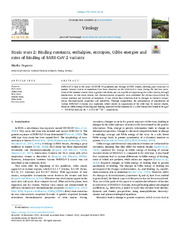Приказ основних података о документу
Thermodynamic insight into viral infections 2: empirical formulas, molecular compositions and thermodynamic properties of SARS, MERS and SARS-CoV-2 (COVID-19) viruses
| dc.creator | Popović, Marko | |
| dc.creator | Minceva, Mirjana | |
| dc.date.accessioned | 2023-05-03T11:54:15Z | |
| dc.date.available | 2023-05-03T11:54:15Z | |
| dc.date.issued | 2020 | |
| dc.identifier.issn | 2405-8440 | |
| dc.identifier.uri | https://cer.ihtm.bg.ac.rs/handle/123456789/6078 | |
| dc.description.abstract | The current situation with the SARS-CoV-2 pandemic indicates the importance of new approaches in vaccine design. In order to design new attenuated vaccines, to decrease virulence of virus wild types, it is important to understand what allows a virus to hijack its host cell's metabolism, a property of all viruses. RNA and protein sequences obtained from databases were used to count the number of atoms of each element in the virions of SARS, MERS and SARS-CoV-2. The number of protein copies and carbohydrate composition were taken from the literature. The number of lipid molecules was estimated from the envelope surface area. Based on elemental composition, growth equations were balanced, and thermodynamic properties of the viruses were determined using Patel-Erickson and Battley equations. Elemental and molecular compositions of SARS, MERS and SARS-CoV-2 were found, as well as their standard thermodynamic properties of formation and growth. Standard Gibbs energy of growth of virus nucleocapsids was found to be significantly more negative than that of their host tissue. The ratio of Gibbs energies of growth of virus nucleocapsids and host cell is greater than unity. The more negative Gibbs energy of growth of viruses implies that virus multiplication has a greater driving force than synthesis of host cell components, giving a physical explanation of why viruses are able to hijack their host cell's metabolism. Knowing the mechanism of viral metabolism hijacking can open new paths for vaccine design. By manipulating chemical composition of viruses, virulence can be decreased by making the Gibbs energy of their growth less negative, resulting in decreased multiplication rate, while preserving antigenic properties. | sr |
| dc.language.iso | en | sr |
| dc.publisher | Elsevier | sr |
| dc.rights | openAccess | sr |
| dc.rights.uri | https://creativecommons.org/licenses/by-nc-nd/4.0/ | |
| dc.source | Heliyon | sr |
| dc.subject | Biophysics | sr |
| dc.subject | Microbiology | sr |
| dc.subject | Virology | sr |
| dc.subject | Thermodynamics | sr |
| dc.subject | Viruses | sr |
| dc.subject | Viral disease | sr |
| dc.subject | SARS | sr |
| dc.subject | MERS | sr |
| dc.subject | SARS-CoV-2 | sr |
| dc.subject | Gibbs energy | sr |
| dc.subject | Virus multiplication rate | sr |
| dc.title | Thermodynamic insight into viral infections 2: empirical formulas, molecular compositions and thermodynamic properties of SARS, MERS and SARS-CoV-2 (COVID-19) viruses | sr |
| dc.type | article | sr |
| dc.rights.license | BY-NC-ND | sr |
| dc.rights.holder | Elsevier | sr |
| dc.citation.volume | 6 | |
| dc.citation.issue | 9 | |
| dc.citation.spage | e04943 | |
| dc.identifier.pmid | 32954038 | |
| dc.identifier.doi | 10.1016/j.heliyon.2020.e04943 | |
| dc.identifier.fulltext | http://cer.ihtm.bg.ac.rs/bitstream/id/25077/bitstream_25077.pdf | |
| dc.identifier.scopus | 2-s2.0-85090903840 | |
| dc.type.version | publishedVersion | sr |


